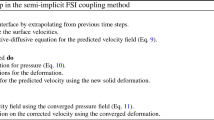Abstract
The parallel performance of an implicit solver for the Euler equations on a structured grid is discussed. The flow studied is a two-dimensional transonic flow around an airfoil. The spatial discretization involves the MUSCL scheme, a higher-order Total Variation Diminishing scheme. The solver described in this paper is an implicit solver that is based on quasi Newton iteration and approximate factorization to solve the linear system of equations resulting from the Euler Backward scheme. It is shown that the implicit time-stepping method can be used as a smoother to obtain an efficient and stable multigrid process. Also, the solver has good properties for parallelization comparable with explicit time-stepping schemes. To preserve data locality domain decomposition is applied to obtain a parallelizable code. Although the domain decomposition slightly affects the efficiency of the approximate factorization method with respect to the number of time steps required to attain the stationary solution, the results show that this hardly affects the performance for practical purposes. The accuracy with which the linear system of equations is solved is found to be an important parameter. Because the method is equally applicable for the Navier-Stokes equations and in three-dimensions, the presented combination of efficient parallel execution and implicit time-integration provides an interesting perspective for time-dependent problems in computational fluid dynamics.
Similar content being viewed by others
References
R. van Buuren, J. G. M. Kuerten, and B. J. Geurts, Instabilities of stationary inviscid compressible flow around an airfoil. J. Comp. Phys. 138 (1997) 520-539.
B. van Leer, Towards the ultimate conservative difference scheme ii. Monotonicity and conservation combined in a second-order scheme. J. Comp. Phys. 29 (1974) 11-31.
H. Yoshihara and P. Sacher, Test Cases for Inviscid Flow Field Methods. Technical report, AGARD-AR-211 (1985).
J. W. van der Burg, Numerical Methods for Transonic Flow Calculations. PhD Thesis, University of Twente, Enschede, The Netherlands (1992) 171pp.
R. Leveque, Numerical Methods for Conservation Laws. Lectures in Mathematics, ETH Zurich, Basel, Birkhäuser Verlag (1992) 214pp.
P. L. Roe, Characteristic-based schemes for the Euler equations. Ann. Rev. Fluid Mech. 18 (1991) 337-365.
H. C. Yee, Computational Fluid Dynamics. Lecture Series 1989-04, Von Karman Institute for Fluid Dynamics (1989).
B. van Leer, Upwind-difference methods for aerodynamic problems governed by the Euler equations. In: B. E. Engquist, S. Osher, and R. C. J. Somerville (eds.), Lectures in Applied Mathematics, 22(2), American Mathematical Society, Rhode Island (1985) 327-336.
W. Hundsdorfer, B. Koren, M. van Loon, and J. G. Verwer, A positive finite-difference advection scheme. J. Comp. Phys. 117 (1995) 35-46.
H. C. Yee, Construction of explicit and implicit shock capturing methods. J. Comp. Phys. 68 (1987) 151-179.
J. W. van der Burg, J. G. M. Kuerten, and P. J. Zandbergen, Multigrid and Runge-Kutta time stepping applied to the uniformly non-oscillatory scheme for conservation laws. J. Eng. Math. 25 (1991) 243-263.
H. Kuerten and B. Geurts, Multigrid acceleration of a block structured compressible flow solver. J. Eng. Math. 14 (1995) 361-370.
W. A. Mulder, Multigrid relaxation for the Euler equations. J. Comp. Phys. 60 (1985) 235-252.
P. W. Hemker and S. P. Spekreijse, Multiple grid and osher's scheme for the efficient solution of the steady Euler equations. App. Num. Math. 2 (1986) 475-493.
W. Hackbusch, Multi-grid Methods and Applications. Springer Series in Computational Mathematics. Springer-Verlag, Heidelberg (1985) 377pp.
P. Wesseling, An Introduction to Multigrid Methods, Chapter 7. Chichester, John Wiley & Sons (1992) 284pp.
M.-H. Lallemand and B. Koren, Iterative defect correction and multigrid accelerated explicit timestepping schemes for the steady state Euler equations. SIAM J. Sci. Comp. 14 (1993) 953-970.
A. Jameson and T. J. Baker, Multigrid solution of the Euler equations for aircraft configurations. Technical report, AIAA-paper 84-0093 (1984).
V. Venkatakrishnan, Preconditioned conjugate gradient methods for the compressible Navier-Stokes equations. AIAA J. 29(7) (1991) 1092-1100.
K. H. Tan, Local Coupling in Domain Decomposition. PhD Thesis, University of Utrecht, Utrecht, The Netherlands (1995) 167pp.
R. Barrett, M. Berry, T. F. Chan, J. Donato J. Demmel, J. Dongarra, R. Pozo V. Eijkhout, C. Romine, and H. van der Vorst, Templates for the Solution of Linear Systems: Building Blocks for Iterative Methods, 2nd Edition. SIAM, Philadelphia, PA (1994) 124pp.
R. van Buuren, J. G. M. Kuerten, and B. J. Geurts, Implicit time accurate simulation of unsteady flow. Submitted.
M. M. Rai and P. Moi, Direct numerical simulation of transition and turbulence in a spatially evolving boundary layer. J. Comp. Phys. 109 (1993) 169-192.
Author information
Authors and Affiliations
Rights and permissions
About this article
Cite this article
Strating, P., Van Buuren, R. Fast Computation of Stationary Inviscid Flow Around an Airfoil. Journal of Engineering Mathematics 35, 437–453 (1999). https://doi.org/10.1023/A:1004454015229
Issue Date:
DOI: https://doi.org/10.1023/A:1004454015229




